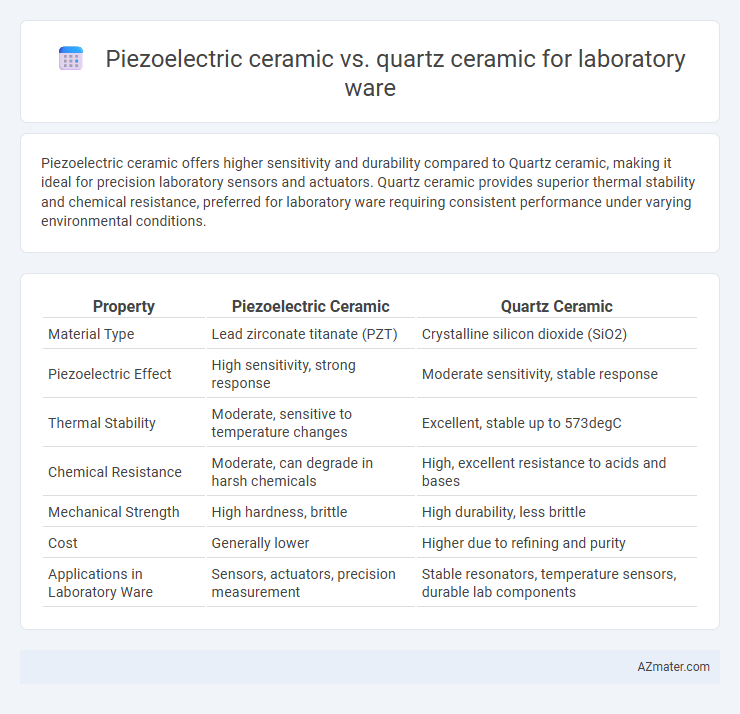Piezoelectric ceramic offers higher sensitivity and durability compared to Quartz ceramic, making it ideal for precision laboratory sensors and actuators. Quartz ceramic provides superior thermal stability and chemical resistance, preferred for laboratory ware requiring consistent performance under varying environmental conditions.
Table of Comparison
| Property | Piezoelectric Ceramic | Quartz Ceramic |
|---|---|---|
| Material Type | Lead zirconate titanate (PZT) | Crystalline silicon dioxide (SiO2) |
| Piezoelectric Effect | High sensitivity, strong response | Moderate sensitivity, stable response |
| Thermal Stability | Moderate, sensitive to temperature changes | Excellent, stable up to 573degC |
| Chemical Resistance | Moderate, can degrade in harsh chemicals | High, excellent resistance to acids and bases |
| Mechanical Strength | High hardness, brittle | High durability, less brittle |
| Cost | Generally lower | Higher due to refining and purity |
| Applications in Laboratory Ware | Sensors, actuators, precision measurement | Stable resonators, temperature sensors, durable lab components |
Overview of Piezoelectric and Quartz Ceramics
Piezoelectric ceramics are engineered materials commonly based on lead zirconate titanate (PZT) compounds, offering high piezoelectric coefficients ideal for precise sensing and actuation in laboratory equipment. Quartz ceramics, derived from crystalline silicon dioxide, exhibit stable piezoelectric properties with exceptional frequency stability and low temperature-dependent drift, crucial for accurate measurements in analytical instruments. The choice between piezoelectric and quartz ceramics depends on application-specific requirements such as sensitivity, environmental stability, and operational frequency range in laboratory ware.
Material Composition and Properties
Piezoelectric ceramics used in laboratory ware typically consist of lead zirconate titanate (PZT), offering high piezoelectric coefficients and excellent electromechanical coupling, which enables precise sensing and actuation. Quartz ceramics feature a highly ordered silicon dioxide (SiO2) crystal structure, providing superior thermal stability, chemical resistance, and long-term durability in precision applications. PZT ceramics excel in sensitivity and energy conversion efficiency, while quartz ceramics are favored for their consistent frequency stability and robustness under harsh laboratory conditions.
Mechanisms of Piezoelectricity
Piezoelectric ceramics, such as lead zirconate titanate (PZT), exhibit high electromechanical coupling due to their polycrystalline microstructure and domain wall motion, enabling efficient conversion between mechanical stress and electrical charge. Quartz ceramics, composed of crystalline silicon dioxide (SiO2), rely on the intrinsic asymmetry of their crystal lattice to generate piezoelectric effects, though with lower coupling coefficients compared to engineered ceramic materials. Mechanistically, piezoelectric ceramics achieve stronger responses through domain switching and polarization reorientation, while quartz's rigid crystal structure results in stable but less intensive piezoelectric behavior suitable for precision laboratory measurement devices.
Performance in Laboratory Applications
Piezoelectric ceramics exhibit higher sensitivity and greater mechanical durability compared to quartz ceramics, making them ideal for precise pressure and vibration measurements in laboratory equipment. Quartz ceramics offer superior thermal stability and frequency consistency, essential for applications requiring long-term accuracy under variable temperature conditions. Selecting between piezoelectric and quartz ceramics depends on the specific laboratory application demands, balancing sensitivity and environmental robustness.
Chemical Resistance and Stability
Piezoelectric ceramics, often composed of lead zirconate titanate (PZT), offer robust piezoelectric properties but exhibit lower chemical resistance and stability compared to quartz ceramics in laboratory ware applications. Quartz ceramics demonstrate superior chemical inertness and thermal stability, making them highly suitable for environments involving aggressive chemicals and fluctuating temperatures. The enhanced durability of quartz ceramics ensures longer lifespan and reliability in precision laboratory instruments where contamination and material degradation must be minimized.
Mechanical Strength and Durability
Piezoelectric ceramics generally exhibit higher mechanical strength and better resistance to mechanical fatigue compared to quartz ceramics, making them more suitable for demanding laboratory ware applications. Quartz ceramics, while offering excellent chemical stability and temperature resistance, tend to be more brittle and less durable under repetitive stress. The enhanced toughness of piezoelectric ceramics ensures longer service life and improved performance in dynamic laboratory environments.
Temperature Tolerance Comparison
Piezoelectric ceramics typically exhibit higher temperature tolerance, functioning effectively up to 300degC, whereas quartz ceramics maintain stability but generally operate within a narrower temperature range around 200degC. The enhanced thermal endurance of piezoelectric ceramics makes them suitable for laboratory ware applications requiring prolonged exposure to elevated temperatures. Quartz ceramics, while more temperature-sensitive, offer superior chemical inertness and dimensional stability under moderate thermal conditions.
Cost Efficiency and Availability
Piezoelectric ceramics offer higher cost efficiency compared to quartz ceramics due to lower raw material and manufacturing expenses, making them more accessible for large-scale laboratory ware applications. Quartz ceramics provide superior stability and precision but come with higher costs and limited availability, often restricting their use to specialized experimental setups. Laboratories prioritizing budget and widespread material availability often prefer piezoelectric ceramics for sensors and actuators in routine testing equipment.
Suitability for Precision Instruments
Piezoelectric ceramic offers higher sensitivity and greater piezoelectric coefficients, making it ideal for precision instruments requiring rapid and accurate response to mechanical stress. Quartz ceramic exhibits superior stability and linearity over a wide temperature range, ensuring consistent performance in high-precision laboratory measurements. The choice between piezoelectric and quartz ceramics depends on the specific demands for sensitivity versus thermal stability in laboratory ware applications.
Environmental and Safety Considerations
Piezoelectric ceramics used in laboratory ware often contain lead-based materials, raising environmental and health concerns due to toxicity and disposal challenges, whereas quartz ceramics are non-toxic and more environmentally benign. Quartz ceramics offer superior chemical stability and are less likely to release harmful substances during use or disposal, enhancing laboratory safety protocols. Selecting quartz ceramics reduces hazardous waste generation and complies better with environmental regulations, making them a safer choice for sustainable laboratory applications.

Infographic: Piezoelectric ceramic vs Quartz ceramic for Laboratory ware
 azmater.com
azmater.com